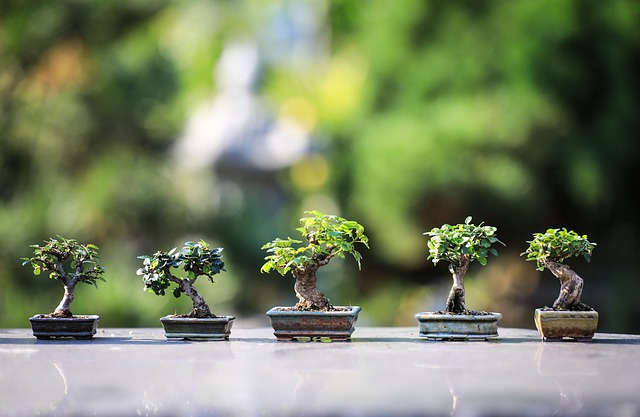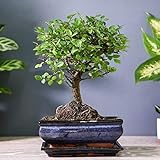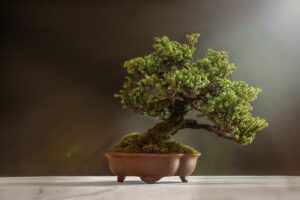Do you want to enter into the bonsai world and you don’t know where to start? This guide will help you get started.
The first thing you will need to figure which bonsai tree to start with and whether it’s an indoor or outdoor tree. This is because bonsai trees need a lot of care and attention. Therefore, as a starter, you need to choose specific bonsai species, which can tolerate some of the mistakes most beginners make.
Some species do better indoors, while others can only survive outdoors. For example, tropical and sub-tropical species do well indoors. Bonsai trees need proper protection from temperatures under -10, though some species do better in the cold than others.
Bonsai enthusiasts prefer to plant and cultivate their bonsai trees right from seeds. But for a beginner, it is recommended that you start with an already thriving bonsai tree.
Table of Contents
Our Best Bonsai Tree Picks
- The Chinese Elm is a bonsai favourite, with perfectly sized leaves and will...
- These Bonsai have a classic 'S' shaped trunk with small green leaves making...
- Planted in a Ceramic Bonsai Pot with matching Ceramic Bonsai Dish - *Please...
- Comes with Ceramic Drip Tray
- Excellent indoor/outdoor bonsai tree
- Comes planted in a 18cm ceramic bonsai pot with drip tray
- Bonsai2u import these trees to get the best possible price
- Pot colour may vary
- Bonsai Zelkova in Ceramic with Saucer Gift Wrapped House Plant Half Hardy...
- Brand : Thompson and Morgan
- Product type: PLANT SEED
- Green
- Supplied with Bonsai2u Care Sheet
- Excellent indoor/outdoor bonsai tree
- Comes with 250ml POKON BONSAI FOOD and 105mm Scissor
- The Chinese Elm is a bonsai favourite, with perfectly sized leaves and will...
- These Bonsai have the classic broom style shape, with small green leaves...
- Planted in a Ceramic Bonsai Pot with matching Ceramic Bonsai Dish - *Please...
Best Bonsai Trees for Beginners Review
Naturally, bonsai trees have small leaves since they are potted and frequently pruned to prevent them from growing to standard trees. Bonsai trees come in various varieties, but the following are the best bonsai trees for beginners:
Juniper Bonsai
Juniper bonsai is an ideal choice for people who always want to have a pop of greenery around their homes. This is because junipers are usually evergreen all year round and look like old pine trees. They have plenty of elegance, thanks to their salient, spreading canopies.
This bonsai tree has a compact appearance since it has twining lower branches and small, dense bristles. Its trunk S-shape with rough bark, and it grows better in different environments. However, it needs sunlight exposure for at least four hours a day though it tolerates cold temperatures.
When properly cared for, juniper is resistant to pests, which is an added advantage for beginners. As it grows, this tree retains most of its hardy qualities since it’s one of the bonsai trees that grow very quickly.
Juniper needs regular pruning to prevent pests infestation. You also have to place it where it will receive adequate rain for its vibrant growth or give it some water when the soil dries up.
Chinese Elm Bonsai
This bonsai tree symbolizes peace, love, and harmony among the people. It falls under semi-deciduous species that usually shed off their leaves seasonally. Chinese elm has dark-green leaves with a lustrous trunk finish that makes it so stunning and lively.
When not trimmed, this bonsai tree can grow up to a height of 60 feet. This is because it has a high tolerance to pruning and wiring; hence it is a perfect choice for bonsai beginners.
Chinese elm does better in both indoor and outdoor, but it needs plenty of sunlight, especially the morning sun. However, the Chinese elm tree grows slowly compared to other bonsai trees. It requires moist soil and needs minimal shelter from extreme weather conditions.
It is easy to prune Chinese elm, and it forgives common mistakes done by beginners. This bonsai tree is not prone to pest infestation, but sometimes it is attacked by spider mites, more so when the humidity is too low.
Hawaiian Umbrella Bonsai
The Hawaiian umbrella is popularly known as one of the best bonsai trees for beginners since it’s easy to take care of. It grows exemplary well in different types of soil and can withstand a variety of light conditions. This bonsai tree belongs to tropical species, and it can stay indoors throughout the year.
Even though the Hawaiian umbrella-like regular moisture, it still thrives well even when you forget to water it frequently. Other than being easy to maintain, this bonsai tree is beautiful and vibrant. It has lavish, deep green leaves that remain evergreen all year round. Its foliage spreads out in an umbrella shape.
This Hawaiian umbrella tree grows well in pots and looks incredibly beautiful when you plant it in groupings. It also prefers moist soils, and you should never leave it to dry out entirely.
This bonsai tree is capable of warning you when you are under or overwatering. When you are under watering, the leaves curl at the tip, while when you are overwatering, the leaves start to turn black. This is an excellent feature for beginners since your Hawaiian umbrella bonsai will recover as soon as you change your watering style.
Ficus Bonsai
Are you looking for your first indoor bonsai tree? Ficus bonsai is a perfect choice for you. You will find more than 800 species of Ficus, with Retusa being the most popular. This bonsai tree symbolizes a new beginning and unity.
It grows very fast, so you will be subjected to regular pruning and trimming. However, you need not worry since the new leaves have a lighter shade of green for easy identification.
Ficus has beautiful dark green leaves and nebari aerial roots, which bonsai enthusiasts appreciate so much. Even though this bonsai tree belongs to the sub-tropical species, it is able to withstand lower light levels compared to other bonsai trees.
Besides, it endures low humidity levels but thrives exemplary better in high levels of humidity. Unlike other bonsai trees, Ficus bonsai tolerates many pruning mistakes since it recovers very quickly.
Another reason why this bonsai tree is suitable for beginners is that it is very forgiving when you over or underwater it plus, it’s resistant to pests.
Japanese Maple Bonsai
Japanese red maple bonsai is popular because of its exquisite leaf colour and bonsai iterations. It’s believed to symbolize love and peace. The maple will add a serene touch to your exterior spaces since it’s so pretty and stunning.
All Japanese maples are deciduous trees, meaning they do well outdoors. There are over 125 species of maple, with the red maple being the most popular.
This bonsai tree has flexible branches, and it has high resiliency to pruning and wiring, making it a perfect choice for novices. Its gorgeous foliage draws many people’s attention, and it’s ideal for adding colour to all your outdoor spaces. However, you can take it inside to allow you to relish its fall foliage for the first few days.
In summer, its leaves are green and then have shades of orange, gold, and deep red when falling.
Japanese maple bonsai tolerates different weather variations and needs little shade from extreme temperatures of the afternoon sun. Also, it requires you to protect it from frost and temperatures under -10.
The maple needs moist soil, and you should not leave it to dry out completely. It does better when it’s outside to be fed with rainwater, which is slightly acidic. Plus, it’s not easily attacked by pests, but it’s susceptible to aphids.
Baby Jade
This is one of the most lovely-looking and fantastic bonsai trees in the world. It is easy to take care of and symbolizes prosperity and friends’ unity. This bonsai tree has unique succulent leaves that are so good in moisture absorption and retention.
It’s characterized by low maintenance since it thrives well when watered irregularly to allow the soil to dry out. This makes it an ideal choice for a beginner since it forgives you when you forget to water it. Plus, it needs bright sunlight. Jade grows well both indoors and outdoors.
Jade features small, dark-green leaves that form a dense canopy, making it plenty of elegance. It sheds off its leaves which later sprouts into vibrant green foliage.
How to Take Care of Bonsai Trees
Now that you know the best bonsai trees for beginners, Let’s look at how to take care of your bonsai trees so that they can grow healthy and vibrant. Seeking information from fellow bonsai gardeners and online sources may help, but here is a comprehensive guide on how to care for your bonsai trees.
Soil
Root growth restriction will help to maintain the miniature size of your bonsai trees. But since bonsai trees have compact root structure, they are easily waterlogged. This is so unhealthy, especially if you have poor drainage soil.
Therefore, it’s advisable to use specialized bonsai soil since it doesn’t compact around the roots of your trees. Also, this specialized soil is professionally blended with high grit levels together with other drainage enhancers.
Water
Water is one of the significant causes of bonsai trees dying by either over or under-watering. Most bonsai varieties need watering every 4-7 days.
But let your leading guide be soil moisture. The majority of bonsai trees grow happy when there is a dry out between drinks. The soil should feel dry on the surface but moist under the surface.
When watering, allow the soil to soak all the water until you see water running out from the drainage holes at the bottom.
Sunlight
Like plants, all bonsai trees require sunlight to produce their own food through photosynthesis. But the necessary amount of the sun merely depends on the type of bonsai species.
Therefore, ensure you place your bonsai trees where sunlight is abundant. If your bonsai trees are indoors, place them at the windowsills.
However, a few bonsai trees are happy in shadier conditions, more so during the afternoon heat.
Pruning
Pruning is a crucial practice for bonsai trees since it allows your trees to flower and regrow again. It helps you to maintain the shape and size of your bonsai tree. It needs a lot of care so that you don’t harm your tree.
If you have bonsai species that grow very fast, you need to prune them regularly. For slow-growing bonsai trees, your trimming seasons will be a bit fewer.
It is good to note that regular trimming is different from structural pruning. Structural pruning involves removing whole branches and large foliage portions to attain your ultimate bonsai size.
Structural pruning should be done annually or after several months since your bonsai trees take a long period to recover.
If you want to clip small twigs, a sharp pair of shears will perfectly do the trick. Larger twigs need to be trimmed with concave shears.
Ensure you minimize scarring as possible so that your bonsai trees can recover fast. As a beginner, you should know that it takes time for new foliage to sprout again after pruning. Therefore, you can clip some branches and leave some.
Fertilizer
Since bonsai trees are usually potted, they don’t get nutrients from the earth. Therefore, they require a nutritional boost by adding fertilizer.
Most species need fertilizer application once a month. But if your trees are outdoors and are experiencing winter dormancy, you don’t need to apply fertilizer. Wait until the beginning of a new season.
Root trimming and Repotting
Repotting involves putting your bonsai tree in another larger pot for more root space. This is a vital process as it helps to limit the growth of your bonsai tree by controlling its pace and ensuring it’s healthy.
You must understand the due repotting process before you start.
Here is a brief step-by-step bonsai repotting procedure:
- Take out your bonsai tree from the pot.
- Remove all the soil from the roots.
- Cut all the tree root’s outer portions, and then empty the old soil from the container.
- At the base, add a layer of lava rock, pebbles, and grit for better drainage, followed by a fresh layer of bonsai soil.
- Put your bonsai tree back into the container and add bonsai soil. Dislodge all the air pockets using a chopstick, and then fill the container with fresh bonsai soil.
- Water your bonsai tree until water submerges the entire container/ pot or water gets out from the drainage holes.
Conclusion
Bonsai trees are elegant and will bring a natural environment to your home. As a beginner, before buying any bonsai tree, make sure you have essential tips on how to take care of it. This is because some mistakes such as over or under watering your bonsai tree might cause your tree to die.
A beginner must choose a bonsai species that tolerate unprofessional pruning and is not sensitive to moisture levels. Your bonsai tree must also be attractive and adaptive to your local climate.








